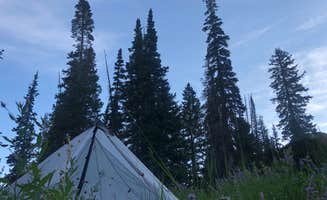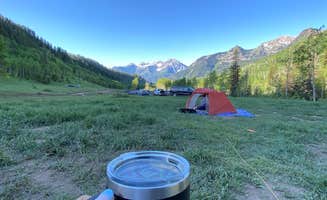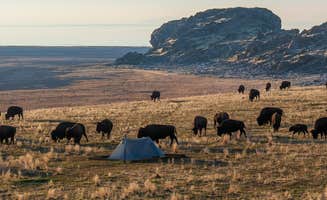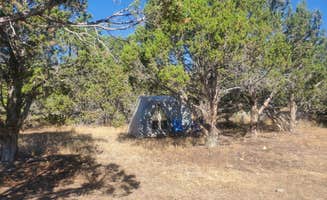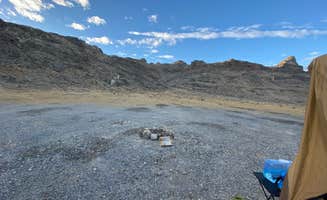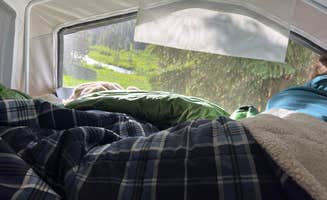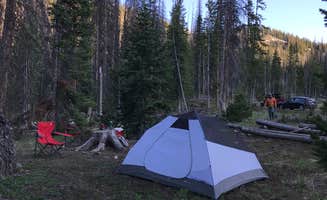Tent camping near West Valley City, Utah offers diverse terrain options from desert landscapes to alpine forests. Most backcountry sites range between 7,000-10,000 feet elevation, creating significant temperature swings of 30-40°F between day and night, even in summer months. Trails into the Wasatch Mountains often have significant elevation gain, with routes climbing 1,500-3,000 feet over 3-5 miles to reach remote campsites.
What to do
Fishing alpine lakes: Silver Lake Backcountry offers excellent fishing opportunities in a stunning mountain setting. "There is also a large bathroom. Some days the parking lot can fill and you'll have to park on the road or a pullout," notes one camper at Silver Lake Backcountry. The lake contains large trout, and fishing licenses are required year-round.
Hike to mountain lakes: The trail to Red Pine Lake provides access to multiple alpine bodies of water. "I also hiked up to the upper red pine lake, which is a very steep climb. The trail is unmarked and nearly impossible to follow (at least for a first-timer), so it requires some creativity and bushwacking/rock hopping to get up there," shares one backpacker. Upper Red Pine Lake sits above 10,000 feet, offering more solitude than the lower lake.
Paddle boarding: Several reservoirs near West Valley City allow non-motorized watercraft. "This is blm land so you can stay for free up to 14 days which was a big factor into why I chose to camp here! Overall I loved it here I totally fell in love with Utah and I can't wait to stop by on my way home and camp here again!" says one visitor about Kimball Campground. The area offers ideal conditions for beginners with protected coves and shallow entry points.
What campers like
Uncrowded weekday camping: Backcountry sites in the Wasatch Mountains see significantly fewer overnight visitors midweek. A camper at Red Pine Lake reports, "If you make your way through the talus field to the south you can gain the ridge and summit white baldy which gives one of the best views in the entire Wasatch!" The area has limited established sites, making weekday visits preferable for finding prime spots.
Winter accessibility: While many mountain roads close seasonally, some areas remain open year-round. "Great hikes to do nearby, beautiful views, and place to paddle board, kayak, etc," mentions a visitor about Silver Lake Backcountry. Winter camping requires proper equipment rated for temperatures that can drop below 0°F in higher elevations.
Proximity to urban areas: Millcreek Canyon Backcountry Camping and Yurts provides relatively close backcountry options. "Millcreek is a great escape from the city. All the camping is backcountry so you can pick any trail and just make sure that you are 1/2 mile off the road and at least 200 ft from developed areas and water," explains one camper. The canyon charges a $5 entry fee per vehicle upon exit.
What you should know
Parking limitations: Many trailheads have restricted parking that fills early on weekends. "Red Pine Lake is located up Little Cottonwood Canyon, on the south side of the road. Parking at the trailhead can be a bit crowded during peak season (between June and September) so arrive early in the day for a good spot," advises a regular visitor.
Permit requirements: Watershed areas have specific regulations. Cook Campsite offers a taste of backpacking close to urban areas. "Aside from the excessive litter in a few places, this was a great place to give my 5 year old a taste of backpacking," shares one parent. Most permits must be obtained before arrival, with limited walk-up options available.
Vehicle clearance needs: Access to remote sites often requires appropriate vehicles. "The roads are really rough don't think you'll be able to do it without 4x4 or awd my Honda CR-V did great," notes a camper about Kimball Campground. Spring conditions can make roads impassable due to snow or mud, especially at elevations above 8,000 feet.
Tips for camping with families
Shorter hikes for beginners: Several areas offer backcountry camping with modest hiking distances. "We backpacked tomorrow Red Pine Lake (first backpacking in 10 years!) and had a great time. The trail up is well kept and the lake itself is stunning. Lots of streams everywhere too which I loved," comments a camper at Red Pine Lake. The trail gains 2,000 feet over approximately 3.5 miles.
Accessible water features: Streams and small lakes provide natural entertainment for children. "We love Millcreek Canyon for camping, hiking, or even just going up for dinner at their day use spots. Pet friendly. One of our families favorite canyons. We take tubes and float in areas of the river. The kids play in the river," shares a regular visitor to Millcreek Canyon.
Group sites availability: Anderson Park offers group camping options closer to town. "This park allows for camping and accommodates small or large groups. Several fire pits, large covered lighted pavilion with three rows of picnic tables," explains a camper. The park charges $25 for site rental with flush toilets available.
Tips from RVers
Desert camping alternatives: When mountain sites are full, Skull Valley Rd Dispersed Camping provides free options. "Tons of dispersed camping areas along the 196. We stayed about 12 miles off of the I-80, on the east side of the 196. Beautiful views, wide open spaces and super quiet. LOTS of mosquitoes and flies," notes an RVer. Sites have no hookups or facilities but allow longer stays up to 14 days.
Weather awareness: Desert camping experiences significant temperature variations. "Especially if you get here before sunset, you can hike a little ways up the mountain and watch the sun go down, but once it does start to go down it gets real windy. All the breeze from the salt flats comes right your way," warns a camper about Skull Valley conditions. Temperature swings of 40°F between day and night are common in desert areas.


